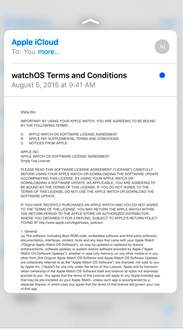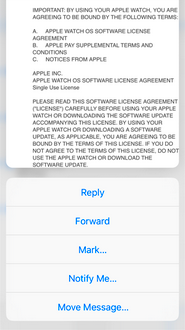3D Touch 介绍
3D Touch 是 Apple 推出的通过压力感触区分轻按和重按来进行不同的用户交互,为 App 增加额外维度上的交互,它支持的系统版本为 i0S 9.0+,机型为 iPhone 6s。
3D Touch的主要应用场景
Apple 文档给出的应用介绍主要有两块:
- 1.A user can now press your Home screen icon to immediately access functionality provided by your app.
2.Within your app, a user can now press views to see previews of additional content and gain accelerated access to features.
第一部分的应用是我们可以通过3D手势,在主屏幕上的应用Icon处,直接进入应用的响应功能模块。这个功能就例如我们上面的日历示例,会在Icon旁边出现一个菜单,点击菜单我们可以进入相应的功能单元。
我个人理解,这个功能,push消息功能加上iOS8推出的扩展today功能,这三个机制使iOS应用变得无比灵活方便,用户可以不需付出寻找的时间成本来快速使用自己需要的功能。
第二部分是对app的一个优化,用户可以通过3D Touch手势在view上来预览一些预加载信息,这样的设计可以使app更加简洁大方,交互性也更强。
3D Touch的主要功能模块
3D Touch 的功能主要分为以下三项:
1、Home Screen Quick Actions
通过主屏幕的应用Icon,我们可以用3D Touch呼出一个菜单,进行快速定位应用功能模块相关功能的开发。如上面的日历。
2、peek and pop
这个功能是一套全新的用户交互机制,在使用3D Touch时,ViewController中会有如下三个交互阶段:
(1)提示用户这里有3D Touch的交互,会使交互控件周围模糊:
(2)继续深按,会出现预览视图:
(3)通过视图上的交互控件进行进一步交互:
这个模块的设计可以在网址连接上进行网页的预览交互。
3、Force Properties
iOS 9 提供了一个新的交互参数:力度。可以检测某一交互的力度值,来做相应的交互处理。例如,我们可以通过力度来控制快进的快慢,音量增加的快慢等。
Home Screen Quick Action使用与相关api详解
iOS 9 提供了两种屏幕标签的设置方式,分别是静态标签和动态标签。
1、静态标签
静态标签是我们在项目的配置plist文件中配置的标签,在用户安装程序后就可以使用,并且排序会在动态标签的前面。
我们先来看静态标签的配置:
首先,在info.plist文件中添加如下键值(我在测试的时候,系统并没有提示,只能手打上去):
先添加了一个UIApplicationShortcutItems的数组,这个数组中添加的元素就是对应的静态标签,在每个标签中我们需要添加一些设置的键值:
必填项(下面两个键值是必须设置的):
UIApplicationShortcutItemType- 这个键值设置一个快捷通道类型的字符串UIApplicationShortcutItemTitle- 这个键值设置标签的标题
选填项(下面这些键值不是必须设置的):
UIApplicationShortcutItemSubtitle- 设置标签的副标题UIApplicationShortcutItemIconType- 设置标签 Icon 类型UIApplicationShortcutItemIconFile- 设置标签的 Icon 文件UIApplicationShortcutItemUserInfo- 设置信息字典(用于传值)
2、动态标签
动态标签是我们在程序中,通过代码添加的,与之相关的类,主要有三个:
UIApplicationShortcutItem- 创建 3D Touch 标签的类UIMutableApplicationShortcutItem- 创建可变的 3D Touch 标签的类UIApplicationShortcutIcon- 创建标签中图片 Icon 的类
主要的类和 API
@interface UIApplicationShortcutItem : NSObject <NSCopying, NSMutableCopying>
//下面是两个初始化方法 通过设置type,title等属性来创建一个标签,这里的icon是UIApplicationShortcutIcon对象,我们后面再说
- (instancetype)initWithType:(NSString *)type localizedTitle:(NSString *)localizedTitle localizedSubtitle:(nullable NSString *)localizedSubtitle icon:(nullable UIApplicationShortcutIcon *)icon userInfo:(nullable NSDictionary *)userInfo NS_DESIGNATED_INITIALIZER;
- (instancetype)initWithType:(NSString *)type localizedTitle:(NSString *)localizedTitle;
- //下面这是一些只读的属性,获取相应的属性值
@property (nonatomic, copy, readonly) NSString *type;
@property (nonatomic, copy, readonly) NSString *localizedTitle;
@property (nullable, nonatomic, copy, readonly) NSString *localizedSubtitle;
@property (nullable, nonatomic, copy, readonly) UIApplicationShortcutIcon *icon;
@property (nullable, nonatomic, copy, readonly) NSDictionary<NSString *, id <NSSecureCoding>> *userInfo;
@end//这个类继承于 UIApplicationShortcutItem,创建的标签可变
@interface UIMutableApplicationShortcutItem : UIApplicationShortcutItem
@property (nonatomic, copy) NSString *type;
@property (nonatomic, copy) NSString *localizedTitle;@property (nullable, nonatomic, copy) NSString *localizedSubtitle;
@property (nullable, nonatomic, copy) UIApplicationShortcutIcon *icon;
@property (nullable, nonatomic, copy) NSDictionary<NSString *, id <NSSecureCoding>> *userInfo;
@end
//这个类创建标签中的 icon
@interface UIApplicationShortcutIcon : NSObject <NSCopying>
// 创建系统风格的icon
+ (instancetype)iconWithType:(UIApplicationShortcutIconType)type;
// 创建自定义的图片icon
+ (instancetype)iconWithTemplateImageName:(NSString *)templateImageName;
@end
系统风格 icon 的枚举:
typedef NS_ENUM(NSInteger, UIApplicationShortcutIconType) {
UIApplicationShortcutIconTypeCompose,
UIApplicationShortcutIconTypePlay,
UIApplicationShortcutIconTypePause,
UIApplicationShortcutIconTypeAdd,
UIApplicationShortcutIconTypeLocation,
UIApplicationShortcutIconTypeSearch,
UIApplicationShortcutIconTypeShare,
UIApplicationShortcutIconTypeProhibit NS_ENUM_AVAILABLE_IOS(9_1),
UIApplicationShortcutIconTypeContact NS_ENUM_AVAILABLE_IOS(9_1),
UIApplicationShortcutIconTypeHome NS_ENUM_AVAILABLE_IOS(9_1),
UIApplicationShortcutIconTypeMarkLocation NS_ENUM_AVAILABLE_IOS(9_1),
UIApplicationShortcutIconTypeFavorite NS_ENUM_AVAILABLE_IOS(9_1),
UIApplicationShortcutIconTypeLove NS_ENUM_AVAILABLE_IOS(9_1),
UIApplicationShortcutIconTypeCloud NS_ENUM_AVAILABLE_IOS(9_1),
UIApplicationShortcutIconTypeInvitation NS_ENUM_AVAILABLE_IOS(9_1),
UIApplicationShortcutIconTypeConfirmation NS_ENUM_AVAILABLE_IOS(9_1),
UIApplicationShortcutIconTypeMail NS_ENUM_AVAILABLE_IOS(9_1),
UIApplicationShortcutIconTypeMessage NS_ENUM_AVAILABLE_IOS(9_1),
UIApplicationShortcutIconTypeDate NS_ENUM_AVAILABLE_IOS(9_1),
UIApplicationShortcutIconTypeTime NS_ENUM_AVAILABLE_IOS(9_1),
UIApplicationShortcutIconTypeCapturePhoto NS_ENUM_AVAILABLE_IOS(9_1),
UIApplicationShortcutIconTypeCaptureVideo NS_ENUM_AVAILABLE_IOS(9_1),
UIApplicationShortcutIconTypeTask NS_ENUM_AVAILABLE_IOS(9_1),
UIApplicationShortcutIconTypeTaskCompleted NS_ENUM_AVAILABLE_IOS(9_1),
UIApplicationShortcutIconTypeAlarm NS_ENUM_AVAILABLE_IOS(9_1),
UIApplicationShortcutIconTypeBookmark NS_ENUM_AVAILABLE_IOS(9_1),
UIApplicationShortcutIconTypeShuffle NS_ENUM_AVAILABLE_IOS(9_1),
UIApplicationShortcutIconTypeAudio NS_ENUM_AVAILABLE_IOS(9_1),
UIApplicationShortcutIconTypeUpdate NS_ENUM_AVAILABLE_IOS(9_1)
} NS_ENUM_AVAILABLE_IOS(9_0) __TVOS_PROHIBITED;
创建好标签后,需要将其添加如application的hortcutItems数组中
- (void)createItemsWithIcons {
UIApplicationShortcutIcon *icon1 = [UIApplicationShortcutIcon iconWithTemplateImageName:@"iCon1"];
UIApplicationShortcutIcon *icon2 = [UIApplicationShortcutIcon iconWithTemplateImageName:@"iCon2"];
UIApplicationShortcutIcon *icon3 = [UIApplicationShortcutIcon iconWithTemplateImageName:@"iCon3"];
// create several (dynamic) shortcut items
UIMutableApplicationShortcutItem *item1 = [[UIMutableApplicationShortcutItem alloc]initWithType:@"com.test.dynamic" localizedTitle:@"Dynamic Shortcut" localizedSubtitle:@"available after first launch" icon:icon1 userInfo:nil];
UIMutableApplicationShortcutItem *item2 = [[UIMutableApplicationShortcutItem alloc]initWithType:@"com.test.deep1" localizedTitle:@"Deep Link 1" localizedSubtitle:@"Launch Nav Controller" icon:icon2 userInfo:nil];
UIMutableApplicationShortcutItem *item3 = [[UIMutableApplicationShortcutItem alloc]initWithType:@"com.test.deep2" localizedTitle:@"Deep Link 2" localizedSubtitle:@"Launch 2nd Level" icon:icon3 userInfo:nil];
// add all items to an array
NSArray *items = @[item1, item2, item3];
// add this array to the potentially existing static UIApplicationShortcutItems
NSArray *existingItems = [UIApplication sharedApplication].shortcutItems;
NSArray *updatedItems = [existingItems arrayByAddingObjectsFromArray:items];
[UIApplication sharedApplication].shortcutItems = updatedItems;
}
3、响应标签的行为
类似推送,当我们点击标签进入应用程序时,也可以进行一些操作,我们可以看到,在applocation中增加了这样一个方法:
- ( void )application:( UIApplication *)application performActionForShortcutItem:(UIApplicationShortcutItem *)shortcutItem completionHandler:( void (^)( BOOLsucceeded))completionHandler NS_AVAILABLE_IOS ( 9 _0);
当我们通过标签进入 App 时,就会在 AppDelegate中调用这样一个回调,我们可以获取shortcutItem的信息进行相关逻辑操作。
这里有一点需要注意:我们在 App 的入口函数:
- ( BOOL )application:( UIApplication *)application didFinishLaunchingWithOptions:( NSDictionary *)launchOptions;
也需要进行一下判断,在launchOptions中有UIApplicationLaunchOptionsShortcutItemKey这样一个键,通过它,我们可以区别是否是从标签进入的 App,如果是则处理结束逻辑后,返回NO,防止处理逻辑被反复回调。
- (void)application:(UIApplication *)application performActionForShortcutItem:(UIApplicationShortcutItem *)shortcutItem completionHandler:(void (^)(BOOL))completionHandler {
NSLog(@"A shortcut item was pressed. It was %@.", shortcutItem.localizedTitle);
if ([shortcutItem.type isEqualToString:@"com.test.deep1"]) {
[self launchViewController1];
}
if ([shortcutItem.type isEqualToString:@"com.test.deep2"]) {
[self launchViewController2];
}
}
注意:
1、快捷标签最多可以创建四个,包括静态的和动态的。
2、每个标签的题目和icon最多两行,多出的会用…省略
Peek and Pop
Peek and Pop
实现 Peek 和 Pop 也非常简单,需要以下步骤:
1、在需要预览的 ViewController 遵循并实现
UIViewControllerPreviewingDelegate协议2、调用
- (id <UIViewControllerPreviewing>)registerForPreviewingWithDelegate:(id<UIViewControllerPreviewingDelegate>)delegate sourceView:(UIView *)sourceView NS_AVAILABLE_IOS(9_0)方法注册该 ViewController3、在
- (nullable UIViewController *)previewingContext:(id <UIViewControllerPreviewing>)previewingContext viewControllerForLocation:(CGPoint)location NS_AVAILABLE_IOS(9_0)代理方法中提供一个预览的 ViewController,并设置好 context 的 sourceRect.4、在
- (void)previewingContext:(id <UIViewControllerPreviewing>)previewingContext commitViewController:(UIViewController *)viewControllerToCommit NS_AVAILABLE_IOS(9_0)方法中调用- (void)showDetailViewController:(UIViewController *)vc sender:(nullable id)sender NS_AVAILABLE_IOS(8_0)
# pragma mark - UIViewControllerPreviewingDelegate
- (UIViewController *)previewingContext:(id<UIViewControllerPreviewing>)previewingContext viewControllerForLocation:(CGPoint)location {
// check if we're not already displaying a preview controller
if ([self.presentedViewController isKindOfClass:[PreviewViewController class]]) {
return nil;
}
// shallow press: return the preview controller here (peek)
UIStoryboard *storyboard = [UIStoryboard storyboardWithName:@"Main" bundle:nil];
UIViewController *previewController = [storyboard instantiateViewControllerWithIdentifier:@"PreviewView"];
return previewController;
}
- (void)previewingContext:(id<UIViewControllerPreviewing>)previewingContext commitViewController:(UIViewController *)viewControllerToCommit {
// deep press: bring up the commit view controller (pop)
UIStoryboard *storyboard = [UIStoryboard storyboardWithName:@"Main" bundle:nil];
UIViewController *commitController = [storyboard instantiateViewControllerWithIdentifier:@"CommitView"];
[self showViewController:commitController sender:self];
}
注意:在开发 Peek and Pop 的过程中,请记住以下原则:
1、让合适的内容支持 Peek and Pop (不要滥用这项特性);
2、始终返回相同的预览界面 (保持一致性和可预测性);
3、不要在preview代理方法中花太多的时间;
4、为 context 设置正确的 sourceRect
Preview Action
在 Preview 的过程中,用户可以上滑来唤出类似 Action Sheet 的菜单。实现这一功能只需要重写 ViewController 中的- (NSArray <id <UIPreviewActionItem>> *)previewActionItems NS_AVAILABLE_IOS(9_0)方法即可。 系统提供了和 UIAlertAction 非常类似的 UIPreviewAction,来实现 UIPreviewActionItem。
与 Action Sheet 不同的是,系统提供了 UIPreviewActionGroup 类,实现子菜单的功能。
其中,UIPreviewAction和UIPreviewActionGroup的 API 很简单,类似于UIAlertAction。
NS_CLASS_AVAILABLE_IOS(9_0) @protocol UIPreviewActionItem <NSObject>
/// UIPreviewAction 的标题
@property(nonatomic, copy, readonly) NSString *title;
@end
typedef NS_ENUM(NSInteger,UIPreviewActionStyle) {
UIPreviewActionStyleDefault=0,
UIPreviewActionStyleSelected,
UIPreviewActionStyleDestructive,
} NS_ENUM_AVAILABLE_IOS(9_0);
NS_CLASS_AVAILABLE_IOS(9_0) @interface UIPreviewAction : NSObject <NSCopying,UIPreviewActionItem>
/// UIPreviewAction 的点击事件
@property(nonatomic, copy, readonly) void (^handler)(id<UIPreviewActionItem> action, UIViewController *previewViewController);
+ (instancetype)actionWithTitle:(NSString *)title style:(UIPreviewActionStyle)style handler:(void (^)(UIPreviewAction *action, UIViewController *previewViewController))handler;
@end
NS_CLASS_AVAILABLE_IOS(9_0) @interface UIPreviewActionGroup : NSObject <NSCopying,UIPreviewActionItem>
+ (instancetype)actionGroupWithTitle:(NSString *)title style:(UIPreviewActionStyle)style actions:(NSArray<UIPreviewAction *> *)actions;
@end
NS_ASSUME_NONNULL_END
Force Properties
iOS 9.0 之后, UITouch类中增加的一些新属性:
@property(nonatomic,readonly) UITouchType type触摸的类型。
typedef NS_ENUM(NSInteger, UITouchType) { // 一个手指(在屏幕上)直接接触 UITouchTypeDirect, // 间接接触 UITouchTypeIndirect, // 触控笔接触 UITouchTypeStylus NS_AVAILABLE_IOS(9_1), } NS_ENUM_AVAILABLE_IOS(9_0);@property(nonatomic,readonly) CGFloat force触摸的压力值,其中 1.0 表示一个平均压力值(有系统预定,而不是用户自己设定)。
@property(nonatomic,readonly) CGFloat altitudeAngle触控笔的高度(弧度)。
@property(nonatomic,readonly) CGFloat maximumPossibleForce触摸的最大可能的压力值。
@property(nonatomic,readonly) UITouchProperties estimatedProperties当前触摸对象估计的触摸特性。
typedef NS_OPTIONS(NSInteger, UITouchProperties) { // 压力除魔属性 UITouchPropertyForce = (1UL << 0), // 方位角除魔属性 UITouchPropertyAzimuth = (1UL << 1), // 海拔高度除魔属性 UITouchPropertyAltitude = (1UL << 2), // 位置除魔属性 UITouchPropertyLocation = (1UL << 3), // For predicted Touches } NS_AVAILABLE_IOS(9_1);@property(nonatomic, readonly) CGFloat altitudeAngle高度值,仅适用于触控笔触摸类型。当笔平行于平面时,该值为0;当笔垂直于平面时,该值为Pi / 2 。
@property(nonatomic,readonly) NSNumber * _Nullable estimationUpdateIndex一个可以让你关联更新后的触摸和原始触摸的索引值,当每个触摸对象的触摸特性发生变化时,该值将会单独增加。
@property(nonatomic,readonly) UITouchProperties estimatedPropertiesExpectingUpdates- 一组触摸属性,希望在未来有传入的更新。如果没有预计属性的更新,当前值是最终的估计值。
iOS 9.0 之后,UITouch类中增添的一些新方法:
- (CGPoint)preciseLocationInView:(UIView *)view;当可用时,返回一个精确的触摸位置。
- (CGPoint)precisePreviousLocationInView:(UIView *)view;当可用时,返回一个精确的前一个触摸位置。
- (CGFloat)azimuthAngleInView:(nullable UIView *)view返回愁莫比的方位角(弧度)。
- (CGVector)azimuthUnitVectorInView:(UIView *)view;返回触控笔的镇的方向上的而单位向量。
获取触摸压力值很简单:
-(void)touchesMoved:(NSSet<UITouch *> *)touches withEvent:(UIEvent *)event {
NSArray *arrayTouch = [touches allObjects];
UITouch *touch = (UITouch *)[arrayTouch lastObject];
NSLog(@"%f",touch.force);
}
附:模拟器 3D Touch 测试方法
在模拟器上是不能使用 3D Touch 功能的,但是难不倒万能的「程序员」。在 GitHub 上出现了一个可以在模拟器上实现 3D Touch 功能的插件 .SBShortcutMenuSimulator,具体使用方法还是移步 GitHub 自行查阅。


























 1273
1273

 被折叠的 条评论
为什么被折叠?
被折叠的 条评论
为什么被折叠?








